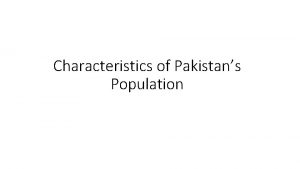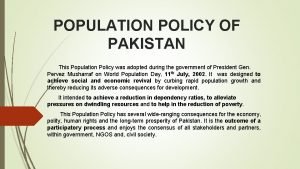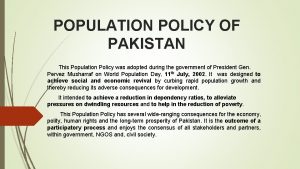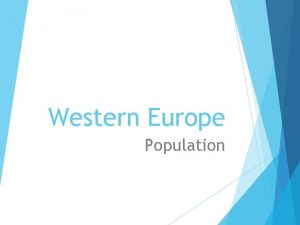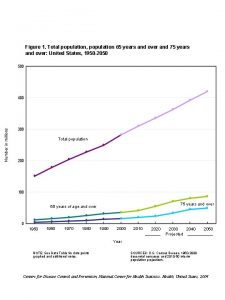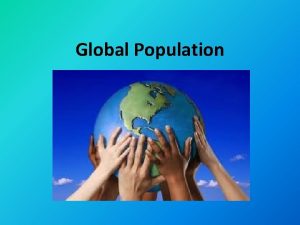Pakistan Pakistan A Preview Total Population 152 5


























- Slides: 26

Pakistan

Pakistan – A Preview Total Population – 152. 5 million Male : Female Proportion – 52 : 48 Urban : Rural Proportion – 33. 4: 66. 6 Population Density / Sq. Km – 187/person Pakistan is the seventh most populous country in the world

Demographic Indicators Pakistan is categorized by high mortality and population growth rates • • Total Fertility Rate Crude Birth Rate Population Growth Rate Infant Mortality Rate Under 5 Mortality Rate Maternal Mortality Ratio Contraceptive Prevalence Rate 4. 07 28 1. 92 82 98 350 34 Economic survey of Pakistan 2004 - 05

MGD 4: Reduce Child Mortality INDICATORS FOR PAKISTAN • Under-five mortality rate • Infant mortality rate • Proportion of fully immunised children (12 -23 months) • Proportion of children < 1 yr immunised against measles • Prevalence of under-weight children (under 5 yrs) • Lady Health Workers’ coverage of target population

MGD 5: Improve Maternal Health INDICATORS FOR PAKISTAN • Maternal mortality ratio • Proportion of births attended by skilled birth attendants • Contraceptive prevalence rate • Total fertility rate • Proportion of women 15 -49 years who had given birth during last 3 years, and made at least one antenatal care consultation

MGD 6: Combat HIV/AIDS, Malaria and Other Diseases INDICATORS FOR PAKISTAN • HIV prevalence among 15 -24 year old pregnant women • HIV prevalence among vulnerable groups (e. g. , active sex workers) • Proportion of population in malaria risk areas using effective malaria prevention and treatment measures • Incidence of tuberculosis per 100, 000 population • Proportion of TB cases detected and cured under Directly Observed Treatment Short Course (DOTS)

MGD 4: Reduce Child Mortality (MGD Goals Report 2004 – Planning Commission of Pakistan) Target 5 Reduce under – 5 mortality by two-thirds Indicators 1990/91 2001/02 2002/03 2005/06 Targets 2011 2015 UNDER 5 MORTALITY RATE 140 105 103 80 65 52 INFANT MORTALITY RATE 102 77 75 63 50 40

MGD 4: Reduce Child Mortality Status at a Glance – Summary of Progress (MGD Goals Report 2004 – Planning Commission of Pakistan) GOAL/ TARGETS Reduce child mortality Reduce under 5 mortality by 2/3 WILL TARGET BE REACHED? Probably Potentially Unlikely STATE OF SUPPORTIVE ENVIRONMENT Strong Fair Weak

MGD 4: Reduce Child Mortality Capacity for Monitoring and Reporting Progress (MGD Goals Report 2004 – Planning Commission of Pakistan) Quality and Regularity of Statistical Analysis Survey Information Strong Fair Weak Statistics in Policy Making Strong Fair Weak Reporting and Dissemination of Information Strong Fair Weak

MGD 5: Reduce Maternal Mortality (MGD Goals Report 2004 – Planning Commission of Pakistan) Target 6 Reduce maternal mortality by three quarters 1990/91 2001/02 2002/03 2005/06 Targets 2011 2015 Maternal mortality ratio 550 350 -400 300 -350 180 140 Births attended by skilled birth attendants 18% 40% 75% 90% >90% Indicators

MGD 5: Reduce Maternal Mortality Status at a Glance – Summary of Progress (MGD Goals Report 2004 – Planning Commission of Pakistan) GOAL/ TARGETS Reduce child mortality Reduce under 5 mortality by 2/3 WILL TARGET BE REACHED? Probably Potentially Unlikely STATE OF SUPPORTIVE ENVIRONMENT Strong Fair Weak

MGD 5: Reduce Maternal Mortality Capacity for Monitoring and Reporting Progress (MGD Goals Report 2004 – Planning Commission of Pakistan) Quality and Regularity of Statistical Analysis Survey Information Strong Fair Weak Statistics in Policy Making Strong Fair Weak Reporting and Dissemination of Information Strong Fair Weak

MGD 6: Combating HIV/AIDS, Malaria and Other Diseases (MGD Goals Report 2004 – Planning Commission of Pakistan) Indicators HIV prevalence among 15 -24 year old pregnant women 1990/91 n/a 2001/02 Nil 2002/03 n/a 2005/06 Targets n/a 2011 2015 n/a Baseline to be reduced by 50%

MGD 6: Combating HIV/AIDS, Malaria and Other Diseases Status at a Glance – Summary of Progress (MGD Goals Report 2004 – Planning Commission of Pakistan) GOAL/ TARGETS Halt & begun to reverse HIV / AIDS WILL TARGET BE REACHED? Probably Unlikely No Data STATE OF SUPPORTIVE ENVIRONMENT Strong Fair Weak but improvi ng

MGD 6: Combating HIV/AIDS, Malaria and Other Diseases Capacity for Monitoring and Reporting Progress (MGD Goals Report 2004 – Planning Commission of Pakistan) Quality and Regularity of Statistical Analysis Survey Information Strong Fair Weak Statistics in Policy Making Strong Fair Weak Reporting and Dissemination of Information Strong Fair Weak

Issues • Inadequate budgetary allocation • High population growth rate • High fertility rate • Focus on curative medicine than the preventive treatment • Poor primary health care services • Lack of integration of vertical Preventive programs

Issues (cont’d) • Inadequate social sector services delivery • Professional and managerial deficiencies • High prevalence of communicable diseases • Lack of integrated management of childhood illnesses • Malnutrition • Low skilled birth attendance rate

Issues (cont’d) • Lack of awareness • Insufficient accessibility to maternal health care services especially emergency obstetric care • Lack of sex education for HIV/AIDS

Advantages / Strengths • • • Health System Infrastructure Improving fiscal environment Functional community-based LHWs Devolution Poverty-alleviation strategies

Government Programs - Health • National Program for Family Planning and Primary Health Care • Food and Nutrition • Women Health Project • Reproductive Health Project • Expanded Program on Immunization • National Maternal and Child Care Program

NCHD – Health Programs Focus is on ensuring access to health services • Primary Health Care Extension • National ORS Campaign • National School Health Program • Strengthening of Primary Health Care System

ROLE OF ICT IN HEALTH • ICTs provide opportunities for individuals, medical professionals and healthcare providers to – obtain information, – communicate with professionals, – deliver first-line support especially where distance is a critical factor and – promote preventive medicine programmes.

APPLICATION OF ICT IN HEALTH • At Referral Hospitals/Regional Hospitals/ District/Sub-district Health Centres, ICT enable: – more effective planning, decision-making and monitoring – improved shared service operations – greater access to more reliable health & population data – more effective resource management

APPLICATION OF ICT IN HEALTH (Cont’d) • Particular value for patients from improved information systems include: – development & use of electronic patient records – multi-media decision support systems – remote monitoring – updating patient notes using wireless Personal Digital Assistants (PDA)

E-HEALTH CHALLENGES • Creating ICT technologists and technicians in health sector at all levels • Attitudes about use of ICT/e-health technologies • Time - Man’s greatest enemy • Achieving consensus • Lack of investment in technology in healthcare sector • Lack of Stakeholder participation

E-HEALTH CHALLENGES Solutions are needed to solve these challenges. How can e-health help to meet health sector challenges?
 Pakistan hindu population 2020
Pakistan hindu population 2020 Characteristics of pakistan
Characteristics of pakistan Population policy of pakistan
Population policy of pakistan Chapter 4 section 1 population dynamics study guide
Chapter 4 section 1 population dynamics study guide Chapter 4 section 1 population dynamics answer key
Chapter 4 section 1 population dynamics answer key Population ecology section 1 population dynamics
Population ecology section 1 population dynamics Population ecology section 1 population dynamics
Population ecology section 1 population dynamics Nnn preview
Nnn preview Benefits of hr forecasting
Benefits of hr forecasting Nút lệnh print preview nằm ở đâu
Nút lệnh print preview nằm ở đâu Test prep preview
Test prep preview Test prep preview
Test prep preview Sccm technical preview
Sccm technical preview Paraverbal communication definition
Paraverbal communication definition Overview skimming
Overview skimming The selection preview
The selection preview Test prep preview
Test prep preview Disadvantages of realistic job preview
Disadvantages of realistic job preview Tams sat score
Tams sat score Perintah print preview kita jalankan dari menu
Perintah print preview kita jalankan dari menu What is a preview statement
What is a preview statement Startling statement introduction examples
Startling statement introduction examples Nnn image preview
Nnn image preview 1984 book preview
1984 book preview What is theses statement
What is theses statement Test prep preview
Test prep preview Test prep preview
Test prep preview

